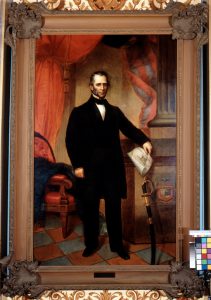LANSING, Mich. (Michigan News Source) – When the first artillery shots erupted at Fort Sumter, sounding the start of the American Civil War 162 years ago today, Michiganders- including roughly 500 from Lansing during the war – had hardly any idea that this would begin a four year war with the greatest casualties in any US conflict.
In late February, Matt VanAcker, Michigan State Capitol Director of Capitol Tours, and Director & Curator of Save the Flags published the culmination of a lifetime’s study and two years of concentrated research and writing, “Lansing and the Civil War,” which codified the impact of Michigan’s Capitol city on the outcome of the war, including its initial response to the attack on the northern held fort in South Carolina on April 12, 1861 that prompted President Lincoln to summon 75,000 troops to aid the base and help quell the initial fighting.
MORE NEWS: Unsealed Lawsuit Places Michigan Camp in Epstein Timeline
“On April 18, a large evening war rally was held in the Hall of Representatives at the capitol,” VanAcker wrote.
Despite some speeches rallying men to fight, no one initially responded, though moments later, the younger brother of Seymour Foster, who’d later see action in the war with the Second U.S. Sharpshooters Regiment, recalled,
“Then a voice rang out: ‘Charles Foster tenders his services and his life if need be to his country and his flag,’” VanAcker wrote of the first Lansing man to enlist, and who would also become the first Lansing soldier killed in action in the Civil War.
It was for Foster, and the many boys Michigan had on almost every battlefield of the war that VanAcker wanted to write the book.
“I just thought It was an important story that should be told, and I also wanted to make sure that some of these boys got credit for what they had done, and the sacrifices they made, most of them would never have their name published in a major book about the civil war because those books concentrate on generals and officers,” VanAcker said, “Even if I could only say one or two sentences about the men who died or fought, I thought they needed to have that recognition.”
While considerably smaller than Detroit and Grand Rapids in 1860, Lansing’s roughly 3,000 residents in 1860 would send more than 50% of all eligible boys and men to serve during the war against the southern states in rebellion, in part because of the response of Michigan’s 13th Governor, Austin Blair, a Republican Statesman who hailed from New York.

“On a per capita basis, our contribution was the largest of any northern state,” VanAcker said, “There were states that sent more men, like New York and Pennsylvania, but they had much larger populations to draw from.”
Similarly, Lansing would also send more than half of its eligible male population to fight in the war.
“Obviously not counting young boys and elderly men who technically weren’t supposed to enlist, although a few of them did,” VanAcker said, “There were a couple instances of guys in their fifties that enlisted, in one case along with their sons.”
Gov. Blair’s efforts helped Michigan provide men, arms, and equipment, in the fight to maintain the Union, and whose state’s response is considered one of the quickest to President Lincoln’s call of all the states west of the Appalachians that reached D.C., despite having to traverse several pro-slavery states to get there.
“Defense of the Capitol was pretty tenuous and the more troops that arrived to defend it the better,” Michigan Historian and writer Jack Dempsey said, “Michigan was a very early responder to help maintain its security from that comes the famous story of Lincoln saying ‘Thank God for Michigan’ because his confidence was buoyed by more troops coming into Washington to safeguard it.”
Off the battlefield, Lansing’s residents also had a profound impact on the war effort. The result of the work of women, including groups such as the Ladies’ Aid Society of Lansing, and the founders and graduates of the Michigan Female College in Lansing were incredible to VanAcker.
“In almost every every edition of the State Republican there were articles about what the Ladies’ Aid Society was up to, and their meetings, where they were meeting, the focus of the meeting, what they were trying to do, and basically encouraging both financial support for the war, but more material: food, canned goods, which they were shipping out to the boys in the field; especially the Lansing companies,” he said.
Midway into the war, the north held a Sanitary Fair which featured many supplies from Lansing.
“Lansing contributed a ton of canned goods, the boys at the Michigan Reform School contributed, Michigan Agricultural College [MSU] contributed, and they shipped out hundreds of barrels of food out to the Sanitary Fair,” VanAcker said, “Even quilts and blankets, socks and mittens, hats, and really a lot of support.”
Michigan’s impact on the battlefield, particularly during the Battle of Antietam in the fall of 1862, in the state of Maryland, would also have war altering consequences.
“That’s a key battle because it gave President Lincoln the ability to issue the Emancipation Proclamation,” Dempsey said, “Without that victory, the proclamation certainly would have been delayed, and that could have changed the war drastically from how it materialized, and Michigan played a big role there.”
He called the Emancipation Proclamation and the subsequent making slavery in the United States illegal a “watershed moment in our history.”
“It transformed the war from trying to put the country back together to putting it back together much differently, now enslaved people would no longer suffer that from a legal standpoint,” he said.
Despite the Union and Confederate Armies suffering the single bloodiest day of combat in modern history with more than 22,000 deaths, Michigan played significant roles at the top and bottom of the fighting.
“There were several generals from Michigan who played key roles, the main one I wrote a different book about, Alpheus Williams,” Dempsey continued, “We had regiments that fought there like the 7th Michigan Regiment basically from the Monroe area, and we had a lot of casualties that were part of the victory.”
Towards the end of the war, Michigan also played a key role in re-electing President Lincoln in 1864 according to Dempsey.
For several years, Dempsey and fellow author Brian James Egen have been raising funds and establishing relationships with park services in Maryland in the hopes of one day erecting a monument dedicated to the men of Michigan that served and died on the fields of Antietam.
“I think it is very important for us to remember a chapter like that in our past so that we understand the contributions Michigan made to the nation that exists today, we have monuments at Gettysburg, Shiloh, and several other battlefields that are very important, but perhaps Antietam is the most important due to the Emancipation aspect,” Dempsey said.
Before even trying to raise money for the monument, he and Egen had to try and determine an approved location which they have at the epicenter of the battlefield which is close to the visitor’s center.
“Once we have the funds and it erected, it’ll be very prominent and very easy for people interested in Michigan’s contributions to visit it,” he said.
Dempsey, like VanAcker, shared how his interest in studying the war began in his childhood with stories.
“I was such a young boy it’s a bit hard to remember, but I’m pretty sure it had to do with the centennial of the civil war, and books and t.v. shows that were being released and captivated my imagination,” Dempsey said, “Since the age of 8 it is something that has really fascinated me, being the crisis that could have ended our nation, and yet out of it came a much better country- more dedicated to equal opportunity than before.”
Authors like Irene Hunt’s Newbery Medal Honor Book, Across Five Aprils, have tried to capture sentiments early in the war through characters like Jethro Creighton, a young boy from Illinois who describes his conception of war.
“War meant loud brass music and shining horses ridden by men wearing uniforms finer than any suit in the stores at Newton; it meant men riding like kings, looking neither to the right nor the left, while lesser men in perfect lines strode along with guns across their shoulders, their heads held high like horses with reins,” Hunt wrote.
The nine year old Jethro knew not what the men of war who survived the “thunder and explosion” endured on a daily basis once they returned home, though VanAcker describes in the final chapters of his book just some of the experiences that survivors endured.
“I talk a little about survivor’s guilt, how these men came home to Lansing, who had survived and had to grapple with their guilt for not only having killed their brothers, but then also the guilt of their survival and coming back,” VanAcker said, “How does a returning soldier reclaim the daily life of a citizen and face the parents, wives, and children of friends buried?”
Family members of those killed in combat such as Reverend Edwarad Meyer had to grapple with the reality of the absence of his son. One of the estimated 20% of the Union’s underage fighters, Henry Meyer, was killed at the Battle of Antietam. After a local paper published a poem titled “Our Boys Are Coming Home” in June 1865, Edward wrote a poem in response, “My Boy’s Not Coming Home.”
Daily reminders such as walking down a particular street in Lansing, running into family members or friends that had died, were some other examples of the struggles survivors of the war faced, but these reminders proved too much for some, who as VanAcker detailed killed themselves rather than continue in agony.
In detailing Lansing’s contributions to the war, VanAcker expressed how he gained a fuller understanding of “service and sacrifice” after studying what soldiers went through and what their families endured to raise children and keep Lansing functioning in their absence.
“A lot of these men were gone for four years and those that were fortunate enough to come home, came home changed from the experience – forever changed,” he said, “I was just really impressed by the level of service and sacrifice that Lansing provided during the war, and again I don’t think I had a clear understanding of what a total commitment to a cause meant back then.”
As Director of the Save the Flags project, VanAcker also oversees the curation and preservation of the capitol’s 240 flags from historic wars, 160 of which are solemn reminders of the Civil War. For each copy of the “Lansing and the Civil War” that is sold, all the proceeds go to help fund operation and preservation costs. Some flags are for public display in Heritage Hall at the capitol or through a viewing window at the Lansing History Museum.
